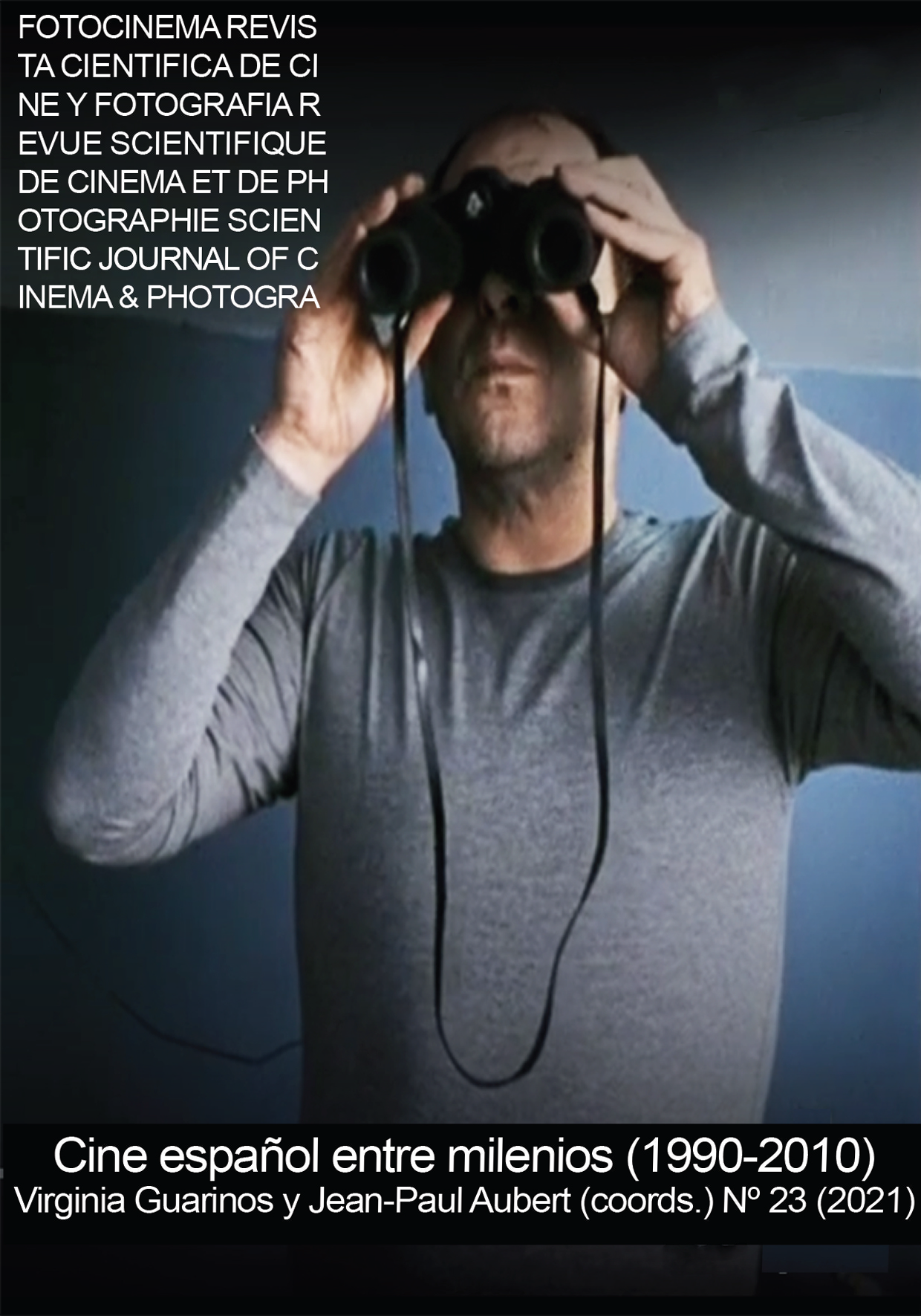Analysis of In the city (2003) by Cesc Gay as an author model in contemporary Spanish cinema.
DOI:
https://doi.org/10.24310/Fotocinema.2021.v23i.12368Keywords:
Spanish cinema, Film analysis, Author`s model, Cesc Gay, En la ciudadAbstract
The Spanish cinema has many virtues, as an industry, as a cultural asset and as a tradition rooted over the years, of the successes and of the profound contributions to the cinematographic medium that its directors and their films have made. One of these virtues is that in the past decades, the end and the beginning of the century, the choice of the personal factor has always predominated as a reference criterion in the making of films. Its directors, for the most part, become authors from that unique artistic personality, which differentiates their films from among many due to the theme, language and way of dealing with stories. In this context, Cesc Gay's cinema, especially his second film, En la ciudad (2003), serves as a guide to analyze the director as an author model of that Spanish cinema between millennia, from the use of language, narrative tools and expressive resources, using an analysis model that allows obtaining related and differential elements, both in his work and in the work of other authors, so that this approach can be extended to other Spanish and European films and directors.
Downloads
Metrics
Publication Facts
Reviewer profiles N/A
Author statements
Indexed in
-
—
- Academic society
- N/A
- Publisher
- Universidad de Málaga
References
Bazin, A. (2008). ¿Qué es el cine? Madrid: Rialp.
Barberá, E. (2008). El declive en el cine de autor. FCR: revista de debat politic núm. 17, pp. 83-85.
De Baecque, A. (2019). La nouvelle vague. Portrait d'une jeunesse. Flammarion.
Faulkner, S. & Cuesta, M. (2017). Una historia del cine español: cine y sociedad, 1910-2010. Frankfurt am Main, Madrid.
Garci?a de Molero, I. y Finol, J. E. (2006). Semio?tica del cine: Un modelo dialo?gico sime?trico/asime?trico para el ana?lisis del texto/discurso fi?lmico. Quo?rum Acade?mico, vol. 3, nu?m. 1, pp. 77-104.
Goytisolo, L. (2017). De autor. El cine y las películas. La revista del Foment núm. 2151, pp. 77 y 78.
Gutiérrez Correa, M. L. (2014). El cine de autor del cine moderno al cine posmoderno. Razón y Palabra núm. 87, Monográfico dedicado a Investigación en Comunicación Aplicada, pp. 1-23.
Heredero, C. & Santamaría, A. (2002). Semillas de futuro. Cine espan?ol 1990- 2001 Nuevo Milenio.
Heredero, C. & Monterde, J. E. (eds.) (2002). En torno a la Nouvelle Vague. Rupturas y horizontes de la modernidad. València: Filmoteca de la Generalitat Valenciana.
Instituto de Cinematografía y del Audiovisual (ICAA) (s.f.), Ministerio de educación cultura y deportes (MECD).
Anuario cine años 1990-2019. Recuperado de http://www.culturaydeporte.gob.es/cultura/areas/cine/inicio.html
Instituto de Cinematografía y del Audiovisual (ICAA) (1999). Anuario de cine 1999. Recuperado de http://www.culturaydeporte.gob.es/dam/jcr:ce947919-c1b1-4eab-a253-6e756f4525de/boletin-1999.pdf
Instituto de Cinematografía y del Audiovisual (ICAA) (2000). Anuario de cine 2000. Recuperado de http://www.culturaydeporte.gob.es/dam/jcr:018a7593-b1c8-4a50-86a9-41e8017f57ba/boletin-2000.pdf
Instituto de Cinematografía y del Audiovisual (ICAA) (2016). Anuario cine años 2016. Recuperado de http://www.culturaydeporte.gob.es/cultura/areas/cine/mc/anuario-cine/anuarios/ano-2016.html
Instituto de Cinematografía y del Audiovisual (ICAA) (2021). Catálogo, Películas clasificadas. (Febrero de 2021). Recuperado de https://sede.mcu.gob.es/CatalogoICAA/Peliculas/Detalle?Pelicula=80614
Las diez películas españolas más taquilleras de la historia. (2021) En Taquilla España. (12 marzo) Recuperado de https://www.taquillaespana.es/estadisticas/peliculas-espanolas-con-mayor-numero-de-espectadores-de-todos-los-tiempos/
Internet Movie Data base. (20 de marzo de 2021) Truman. España. Recuperado de https://www.imdb.com/title/tt3754940/
Malpartida Tirado, R. (2012). Apuestas de riesgo: el último cine de autor español. En F. J. Salvador Ventura, Cine y autor. Reflexiones sobre la teoría y la praxis de creadores fílmicos. Intramar Ediciones, pp. 11-30.
Moncasí, A. V. I. (2016). Entre la representación y la figuración. El cine de la Nouvelle Vague: una revisión histórica. Historia y comunicación social, 21(1), 221.
Partearroyo, D. (2015) Magical Girl atrae a más público en Francia que en España. Cinemanía. Recuperado de https://www20minutos.es/cinemania/
Riambau, E, Torreiro, C. (1995). La escuela de Barcelona: el cine de la gauche divine. Barcelona: Anagrama.
Taborda-Hernández, E. (2014). El Autor y el proceso creativo cinematográfico español de los noventa. Madrid: Universidad Complutense de Madrid.
Torreiro, M. (s.f.): Crítica Diario El País. En la ciudad Filmaffinity. Recuperado de https://www.filmaffinity.com/es/film515035.html
Downloads
Published
How to Cite
Issue
Section
License
All contents published in Fotocinema Revista científica de cine y fotografía are protected under the Creative Commons Attribution-NonCommercial-ShareAlike 4.0 International (CC BY-NC-SA 4.0) license. All about this license is available in the following link: <http://creativecommons.org/licenses/by-nc-sa/4.0>
Users can copy, use, redistribute, share and exhibit publicly as long as:
- The original source and authorship of the material are cited (Journal, Publisher and URL of the work).
- It is not used for comercial purposes.
- The existence of the license and its especifications are mentioned.
There are two sets of authors’ rights: moral and property rights. Moral rights are perpetual prerogatives, unrenounceable, not-transferable, unalienable, imprescriptible and inembargable. According to authors’ rights legislation, Fotocinema. Revista científica de cine y fotografía recognizes and respects authors moral rights, as well as the ownership of property rights, which will be transferred to University of Malaga in open access. The property rights are referred to the benefits that are gained by the use or the dissemination of works. Fotocinema. Revista científica de cine y fotografía is published in an open access form and it is exclusively licenced by any means for doing or authorising distribution, dissemination, reproduction, , adaptation, translation or arrangement of works.
Authors are responsable for obtaining the necessary permission to use copyrighted images.














13.png)



